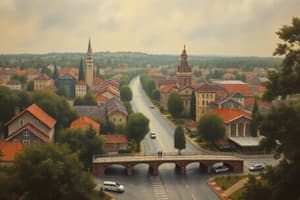Podcast
Questions and Answers
What is a potential benefit of urban sprawl?
What is a potential benefit of urban sprawl?
- Higher property taxes
- Increased environmental degradation
- Increased traffic congestion
- Greater access to public parks (correct)
Which of the following is commonly cited as a disadvantage of urban sprawl?
Which of the following is commonly cited as a disadvantage of urban sprawl?
- Loss of agricultural land (correct)
- Increase in local business opportunities
- Enhanced community engagement
- Transportation improvements
How can urban sprawl negatively impact the environment?
How can urban sprawl negatively impact the environment?
- It can cause habitat destruction (correct)
- It can increase habitat preservation
- It can decrease energy consumption
- It can lead to reduced air pollution
Which of these outcomes is NOT typically associated with urban sprawl?
Which of these outcomes is NOT typically associated with urban sprawl?
Flashcards
Urban Sprawl
Urban Sprawl
The spread of urban development outward from city centers into surrounding areas.
Car Dependency
Car Dependency
Increased car dependency, as more people rely on driving to get around.
Habitat Loss
Habitat Loss
The loss of natural habitats and wildlife areas due to development.
Increased Energy Consumption
Increased Energy Consumption
Signup and view all the flashcards
Air Pollution
Air Pollution
Signup and view all the flashcards
Study Notes
Definitions
-
Gentrification: Older neighborhoods are replaced with new construction, like shops and housing on the ground floor.
-
Infill: Empty or run-down areas within a city are filled with new development.
-
Metropolitan area: A large population center containing a large city and surrounding smaller towns and suburbs.
-
Rural fringe: Small towns, farms, and open spaces bordering a city's suburbs.
-
Suburbs: Developed areas located at the edge of a city, primarily residential but also containing stores and businesses
-
Urban Core: The older part of a large city, including the downtown and central business district.
-
Urban Fringe: The ring of small towns and suburbs surrounding a large city.
-
Urban Sprawl: The rapid, often unplanned, expansion of development from a city into surrounding rural areas.
Pros and Cons of Urban Sprawl
-
Pros*
-
Lower building costs: Building in rural areas is typically less expensive.
-
More desirable homes: Homes outside the city are often considered better places to raise a family.
-
Increased business and jobs: Building new houses creates new business opportunities and jobs.
-
Cons*
-
Increased reliance on cars: Sprawl leads to increased car use, causing traffic congestion and air pollution.
-
Habitat loss: Development destroys natural habitats and wildlife.
-
Higher taxes: Construction companies, infrastructure expansion, and sprawl contributes to increased taxes.
-
Poorly planned development: Often badly planned and leads to environmental issues.
Urban Sprawl Movement
- Urban sprawl begins as a compact urban core.
- Development expands outward, forming an urban fringe.
- The urban fringe is followed by rural open land (rural fringe).
Key Concepts
- Mixed-use development
- Public transportation system
- Smart Growth
- Traffic
- Urban growth boundary
Studying That Suits You
Use AI to generate personalized quizzes and flashcards to suit your learning preferences.



